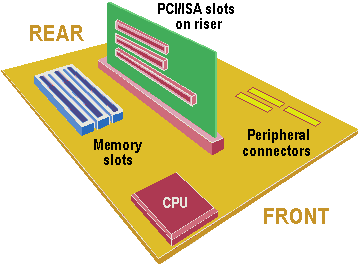The LPX format is a specialised variant of the Baby-AT used in low profile desktop systems and is a loose specification with a variety of proprietary implementations.

Expansion slots are located on a central riser card, allowing cards to be mounted horizontally. However, this arrangement can make it difficult to remove the motherboard, and the more complex engineering required adds to system costs. As the riser card prevents good airflow within the system case, additional chassis fans are almost always needed.
Used commonly in the early 1990s, the format fell out of favour with the introduction of the Pentium II and AGP graphics cards in 1997. The extra space and cooling required for these components highlighted the LPX’s problems, so the form factor was last used in 1998.
- Evolution of the motherboard
- BIOS – What motherboard BIOS does for a PC
- CMOS – complementary metal oxide silicon – RAM chips on motherboards
- EFI – Extensible Firmware Interface – explained
- Motherboard form factors
- Baby AT (BAT) Motherboard Form Factor
- LPX – Low Profile eXtension motherboard form factor
- ATX form factor
- NLX – New Low profile eXtended – form factor for motherboards
- Micro ATX motherboard form factor
- FlexATX motherboard form factor
- BTX – Balanced Technology eXtended – Motherboard Form Factor
- Riser architectures for motherboards
- CPU interfaces – motherboard slots and sockets for AMD and Intel processors